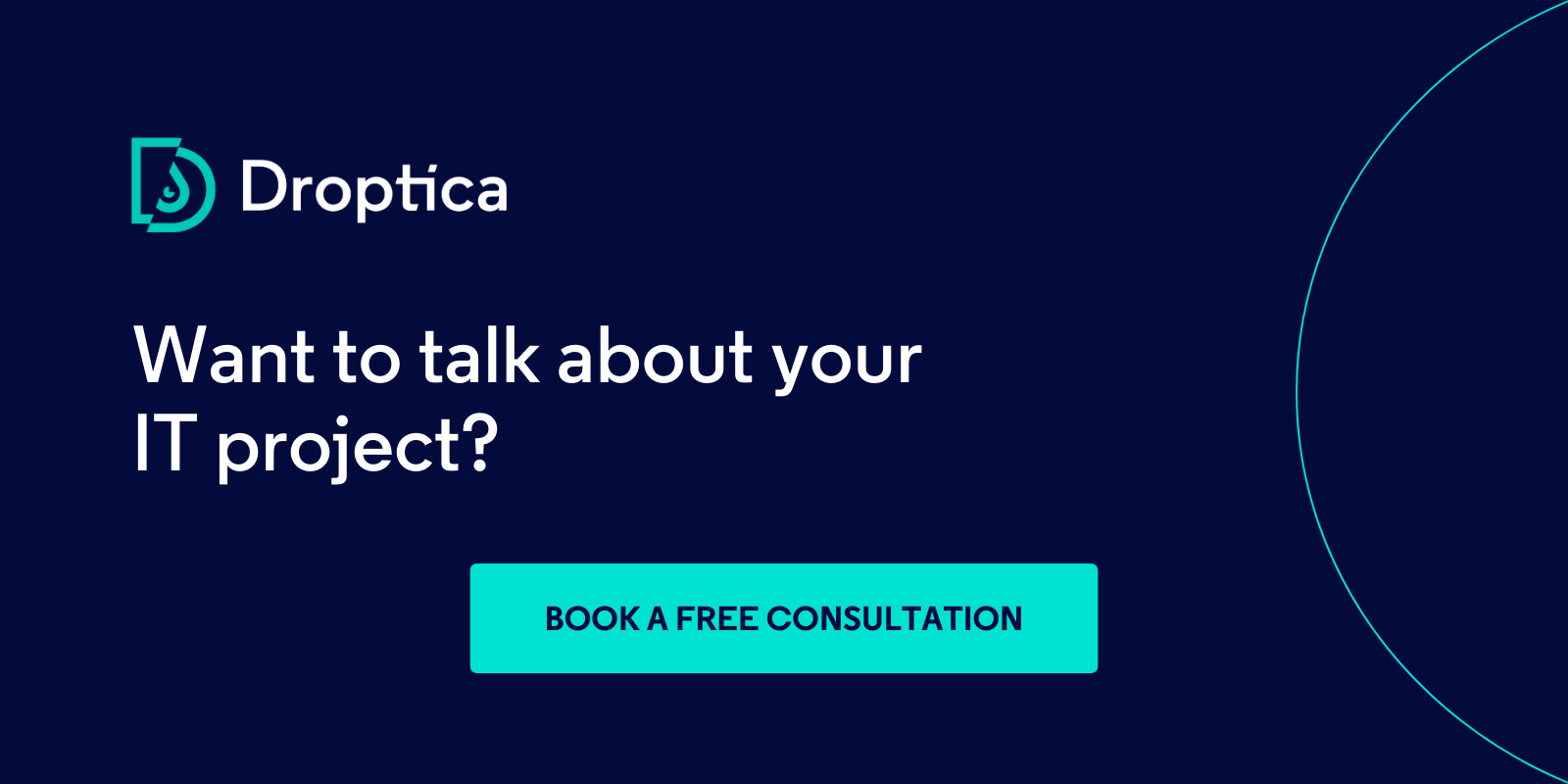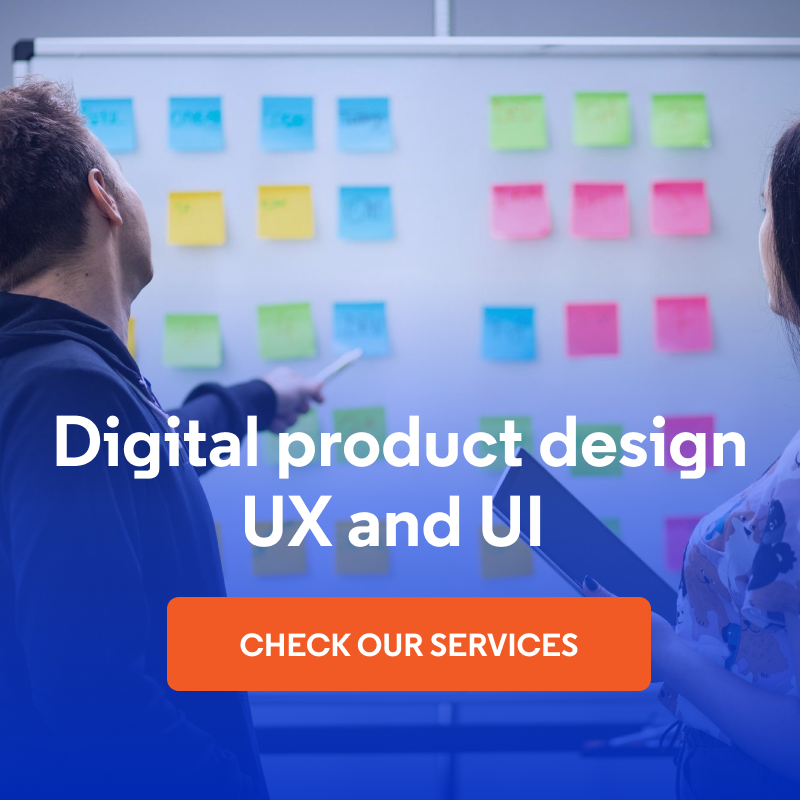
How to Prepare for a New IT Project and Pitch the Idea to the Board or Investors?
When planning a new project, every small decision the board, investors, or stakeholders make has a significant and long-term impact on its future. Proper planning, verification of ideas, and defining the project scope are crucial to ensure the software addresses and solves business requirements. At Droptica, we offer consulting services and assist in developing materials to facilitate communication between the project manager and decision-makers. We understand business processes within organizations and strive to provide our clients with tools to align various visions and plans, ensuring the final project is coherent and effective. Here's how it works in practice.
Ensure confidence in your decisions
Over many years of working on projects, we've often observed that clients aren’t entirely confident in their decisions regarding the project's scope, technology, process, or budget. In such cases, they rely on what different agencies propose (often, companies simply propose what they offer). Ultimately, clients choose the most advantageous offer without knowing if it genuinely makes sense or aligns with their expectations.
These situations highlighted the need for solid consultations at the purchasing stage. Why should we estimate and plan a project as a software house if we aren’t certain that all the best and worst scenarios have been at least discussed and understood? Are all the pros and cons of a given approach or technology truly known? Do the benefits of the technology really address the client's business needs, or have we considered alternatives?
Each such question prompts deeper exploration and proper planning. Therefore, instead of proposing solutions, we primarily focus on advisory services. Through consulting sessions, we help clients thoroughly articulate project requirements and understand the project's strategic context. After such discussions, the project manager is fully prepared for internal talks with decision-makers.

Below are some sample questions we ask during the advisory stage. Considering these factors will equip you with the proper knowledge, protecting you from difficult issues during internal meetings:
- What stage of the project purchase process are you in?
This helps determine whether you’re just at the idea stage and aiming to gather knowledge or have already decided on a specific concept and are looking for implementation offers.
- If you have a concept, how was it defined?
Ensuring that your plans are well-thought-out and founded on solid analyses is crucial.
- How did you choose the technology?
Was your decision preceded by proper analysis or just based on available options or third-party recommendations?
- Do you know all available alternatives and tools that can streamline your work?
Considering different options might help discover more cost-effective or faster-to-implement solutions.
- Is your purchase strategy well-thought-out?
Have you included all key stakeholders, including potential customers, users, sales, marketing, product management, legal, and security departments, in the decision-making process?
- Is the product concept based on the actual needs of the end-user?
Verifying this ensures that the project will not only realize your vision but also meet specific market or user requirements.
- How confident are you about your budget and timeline?
Budget assumptions that aren’t based on thorough analysis can lead to overpaying or undervaluing the project estimation. The project doesn’t have to be as expensive as you assumed.
Conversely, negotiating and minimizing the project scope to fit a strict (sometimes too low) budget can result in a poor-quality product that doesn’t meet user requirements.
Considering these questions with all stakeholders ensures that every aspect of the project is carefully thought through and collectively accepted, minimizing the risk of potential project failures. This approach gives investors or decision-makers a sense of security.
It’s likely that as a result of these consultations, your purchase process might take longer than initially planned, but you’ll ensure that you’re proceeding correctly and rationally. Remember that the project ordering process consists of many small tasks and works that are worth doing with a trusted and competent agency.
Creating and optimizing materials - pitching and pitch decks
Before I dive into how we can specifically help you prepare to present your project idea, let’s briefly explain what pitching is in IT projects.
Pitching an IT project is the process of presenting a technological project idea to potential investors or company decision-makers in order to secure funding, support, or project approval.
This process differs slightly depending on the context, whether the pitch is directed at external investors (typical for startups) or the company board (common in larger companies).
| Context | Startups vs investors | Executive function vs board |
| Goal of pitching |
|
|
| Problem |
|
|
| Solution |
|
|
| Market |
|
|
| Business model |
|
|
| Team |
|
|
| Traction |
|
|
| Finance |
|
|
| Implementation plan |
|
|
| Risk analysis |
|
|
| Presentation style |
|
|
| Discussion and feedback |
|
|
Working with us, clients can develop so-called pitch decks, which are project presentations. The main goal of a pitch deck is to convince the audience of the project's value and gain approval and support (usually financial). Our team of experts helps prepare content for all topics listed in the table above, ensuring they are clear, convincing, and resonate with the intended audience.
Our approach - concept, design, implementation
We can assist at every stage of project planning and validation. We offer various services designed to deliver specific tangible results that support our clients in internal decision-making processes and communication with other organizational stakeholders.
| Service Name | Service Goal | Service Description | Client Result | Duration |
| Discovery workshop | Address all business requirements and translate them into technical solutions. | Sessions that facilitate a deep understanding of project goals and requirements, aligning all stakeholders on a common goal. | A detailed report with defined project goals and implementation strategies is a result. | ~3-5 days |
| Proof of Concept (PoC) | Verify whether a business requirement (e.g., integration with critical applications) is possible and meets user needs. | This service allows for the quick verification of ideas, providing the necessary evidence to gain stakeholder engagement. | Clients receive a detailed document and a demo version of the project, including technical and business analysis and confirmation of project feasibility. | ~2-4 weeks |
| User Experience Design (UX) | Verify whether the new project meets user needs using ready-made mockups. | We conduct in-depth interviews, heuristic analysis of the current project, and create high-level mockups and information architecture. | The result is research reports, mockups, and information architecture that help understand the expected system behavior. Mockups can be directly clicked and tested by end-users and clients. | ~2-6 weeks |
| User Interface Design (UI) | Create the final interface look to help visualize the project concept. | The service focuses on creating an aesthetic and user-friendly interface, which is crucial for the end product's usability value. | The results are visual interface designs that are ready for implementation. We can also create a clickable prototype that behaves like the final application, which is very helpful for visualizing the project for the board or investors and streamlines implementation work for developers. | ~2-8 weeks |
| Minimum Viable Product (MVP) | Deliver a basic version of the product, meeting all critical project requirements. This is a ready-project version that you can further develop over time. | Develop an MVP that allows for iterative improvement based on actual user feedback and market response. | A functioning MVP ready for market testing and business verification is a result. | ~4-12 weeks |
What are the risks of a poorly thought-out project?
A poorly defined project scope or improperly planned timeline and budget can lead to numerous problems, such as:
- Inability to scale the project
As the project grows, a lack of flexibility and adaptability can lead to further development and scaling issues. - Reputational damage
A failed project can negatively impact the company's or startup's image, discouraging customers and investors from future cooperation. - Non-compliance with regulations and standards
Failure to comply with legal requirements, industry norms, or security standards can result in fines, sanctions, and additional costs associated with project adjustment. - High stress and team burnout
Due to work overload, time pressure, and unclear goals, employees may experience stress and burnout, which can lead to decreased efficiency and morale. - Financial losses
Unsuccessful investments in poorly thought-out projects can lead to significant financial losses, which may be difficult to recover, especially for startups with limited resources. - Difficulty obtaining future investments
A failed project can deter current and potential investors from engaging in future company ventures, limiting growth and expansion opportunities.
To avoid these pitfalls, proper planning and resource management are crucial. A well-organized project runs smoothly and effectively addresses the business needs of the company and its clients or users.
We understand that creating a successful project depends on a holistic approach that includes both technical execution and strategic planning. Implementing the project in phases, continuously reviewing progress and validity, and adapting to change are the keys to victory.
Our values and client focus
At Droptica, we don’t mindlessly sell our favorite technology. Our company's DNA deeply emphasizes prioritizing the client's and their product users' well-being. We ensure the proposed options are feasible and genuinely address specific business problems. Only on this basis do we select the appropriate technical solutions.
Sometimes, we substantively challenge clients' initial assumptions if our experience indicates that the chosen concept isn’t the most beneficial. We aren’t afraid to say this openly. Such an attitude brings additional value to our clients. We are not just an agency that performs tasks but a partner that supports clients in minimizing risks and maximizing the project's potential. This way, they receive technical solutions and comprehensive support to achieve their business goals.
Consult your project for free before a business presentation
Contact us if you’re preparing for a key presentation to the board or investors and need expert advice or assistance. Schedule a free consultation with our project concept specialist, who can provide personalized tips and support. By talking to an expert, you’ll learn about various options at the purchase stage that you can consider to make an informed decision.
What happens when you schedule a meeting?
- You’ll connect with a consultant for a free online conversation (Google Meets) - no login is required. Just enter the meeting link.
- The consultant will ask about your plans - from general to specific.
- We’ll create a plan for your next steps.
- You’ll receive a quote for the following consulting and project services.
- You decide if you want to continue the cooperation.











